Slegg, Albert Edward
Killed in Action 1943-12-02


Birth Date: 1917-July-08
Born:
Home: Perth, Ontario
Enlistment:
Enlistment Date: Unknown
Service
RCAF
Unit
432 (B) Sqn- Squadron
Saeviter Ad Lucem Ferociously toward the light
Base
RAF East Moor
Rank
Flight Sergeant
Position
Flight Sergeant
Service Numbers
R/135879
Home
 Perth, Ontario
Perth, Ontario
Target
 Berlin Germany
Berlin Germany
First Burial
 Berlin War Cemetery, Charlottenburg, Germany
Berlin War Cemetery, Charlottenburg, Germany
Lancaster Mk.II LL618
Bombing Berlin Germany 1943-December-02 to 1943-December-02
(B) Sqn (RCAF) East Moor
Battle of Berlin
458 aircraft - 425 Lancasters, r8 Mosquitoes, 15 Halifaxes. There were no major diversions and the bombers took an absolutely direct route across the North Sea and Holland and then on to Berlin
. The Germans identified Berlin as the target 19 minutes before Zero Hour and many fighters were waiting there. Incorrectly forecast winds scattered the bomber stream, particularly on the return flight, and German fighters scored further victories here. A total of 40 bombers - 37 Lancasters, 2 Halifaxes, I Mosquito-were lost, 8·7 per cent of the force. 460 (Australian) Squadron lost 5 of its 25 Lancasters on this raid, including the aircraft in which two newspaper reporters were flying. These were Captain Grieg of the Daily Mail and Norman Stockton of the Sydney Sun. The body of Mr Stockton is buried in the Berlin War Cemetery.
The inaccurate wind forecast caused great difficulties for the Pathfinders, who were not able to establish their positions correctly. The bombing photographs of the Main Force suggested that the attack was scattered over a wide area of southern Berlin and the countryside south of the city. The Berlin report confirms this but adds damage was caused in industrial areas of the eastern and western districts, with two more of the Siemens factories, a ball-bearing factory and several railway installations being badly hit. Damage elsewhere was light, only 136 building: being destroyed. 36 people were killed and a further 105 were classed as 'missing'. (I is noticed again and again that, as the war progressed, German reports become mon erratic or incomplete. The 'final report' - Schlussbericht -for this raid is missing from the Berlin archives.)
source: The Bomber Command War Diaries, Martin Middlebrook and Chris Everitt
Lancaster aircraft LL 618 missing from night operations over Berlin, Germany. Flight Lieutenant S.W. Baker, WOs G.P. Lowle, A.R. Morgan, FS J.R. Goodwin, A.E.Slegg, Sergeants W.H. Green, WE Stinson, and J. Wadsworth (RAF) were kilted. There were two pilots on board for this trip.
Lancaster LL618
Avro Lancaster

Canadian Warplane Heritage Museum
The Avro Lancaster is a British Second World War heavy bomber. It was designed and manufactured by Avro as a contemporary of the Handley Page Halifax, both bombers having been developed to the same specification, as well as the Short Stirling, all three aircraft being four-engined heavy bombers adopted by the Royal Air Force (RAF) during the same wartime era.
The Lancaster has its origins in the twin-engine Avro Manchester which had been developed during the late 1930s in response to the Air Ministry Specification P.13/36 for a capable medium bomber for "world-wide use". Originally developed as an evolution of the Manchester (which had proved troublesome in service and was retired in 1942), the Lancaster was designed by Roy Chadwick and powered by four Rolls-Royce Merlins and in one version, Bristol Hercules engines. It first saw service with RAF Bomber Command in 1942 and as the strategic bombing offensive over Europe gathered momentum, it was the main aircraft for the night-time bombing campaigns that followed. As increasing numbers of the type were produced, it became the principal heavy bomber used by the RAF, the Royal Canadian Air Force (RCAF) and squadrons from other Commonwealth and European countries serving within the RAF, overshadowing the Halifax and Stirling. Wikipedia
432 (B) Sqn Saeviter Ad Lucem ("Leaside")
History of the Squadron during World War II (Aircraft: Wellington X, Lancaster II, Halifax III, VII)
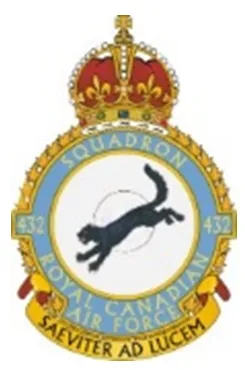
The Squadron was the twelfth RCAF bomber squadron to be formed overseas in WWII. It was formed on May 1, 1943 at Skipton-on-Swale, Yorkshire, UK as a unit of No 6 (RCAF) Group of RAF Bomber Command: indeed, it was the first bomber squadron to be formed directly into No 6 Group. Using the squadron identification letters QO it flew Vickers Wellington Mk X medium bombers until it moved to East Moor, Yorkshire on 19th September 1943, when it re-equipped with Avro Lancaster Mk II aircraft. East Moor was part of No 62 (RCAF) Base. The squadron re-equipped with Handley Page Halifax Mk III aircraft in February 1944, and with Halifax Mk VII in July of that year, and continued with them until the squadron was disbanded at East Moor on May 15, 1945.
In the course of operations the squadron flew 246 missions, involving 3130 individual sorties, for the loss of 73 aircraft. 8980 tons of bombs were dropped. Awards to squadron members included 2 DSOs, 119 DFCs,1 Bar to DFC, 1 CGM, 20 DFMs and 1 Croix de Guerre (France). Battle Honours were: English Channel and North Sea 1943, Fortress Europe 1943-44, France and Germany 1944-45, Biscay Ports 1944, Ruhr 1943-45, Berlin 1943-44, German Ports 1943-45, Normandy 1944, Rhine, Biscay 1943.Moyes, Kostenuk and Griffin
Squadron History (Bomber Command Museum PDF)
Maps for Movements of 432 Squadron 1943-45
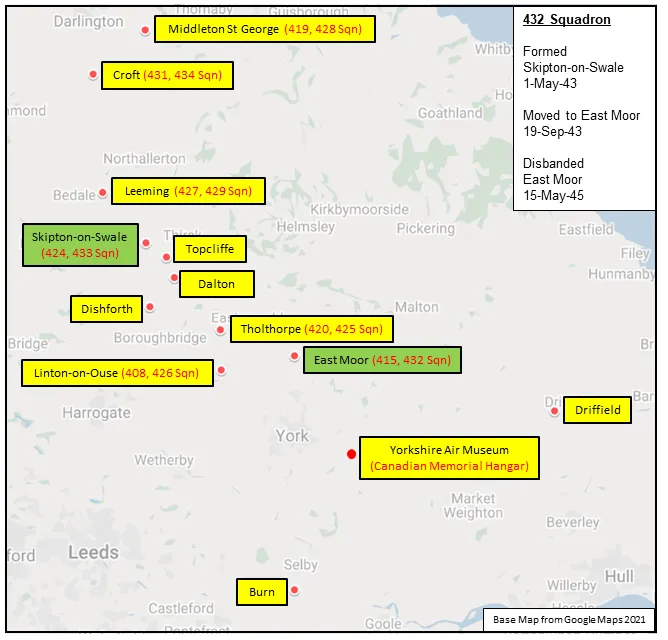
432 Squadron History Summary 1943-45
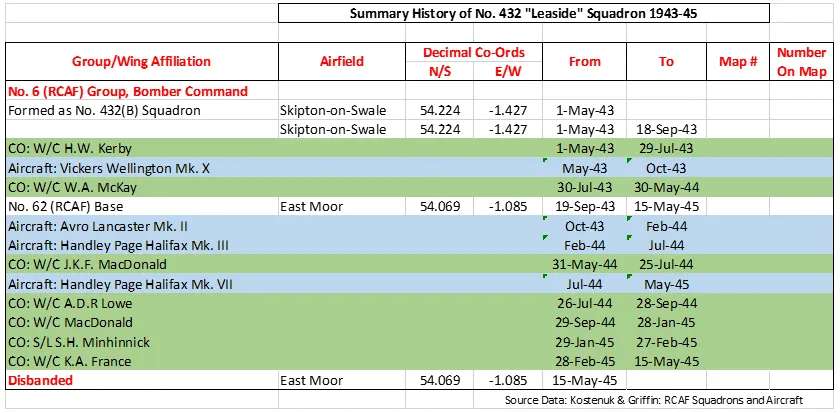
History of the Squadron Post-WWII (Aircraft: Canuck)
The squadron was re-formed at Bagotville, Quebec as an All-Weather Fighter unit on 1 October 1954. The squadron flew Avro CF-100 Canuck aircraft on North American Air Defence until it was disbanded on 15 October 1961.
 Canadian Virtual War Memorial
Canadian Virtual War Memorial Commonwealth War Graves Commission
Commonwealth War Graves Commission www.findagrave.com
www.findagrave.com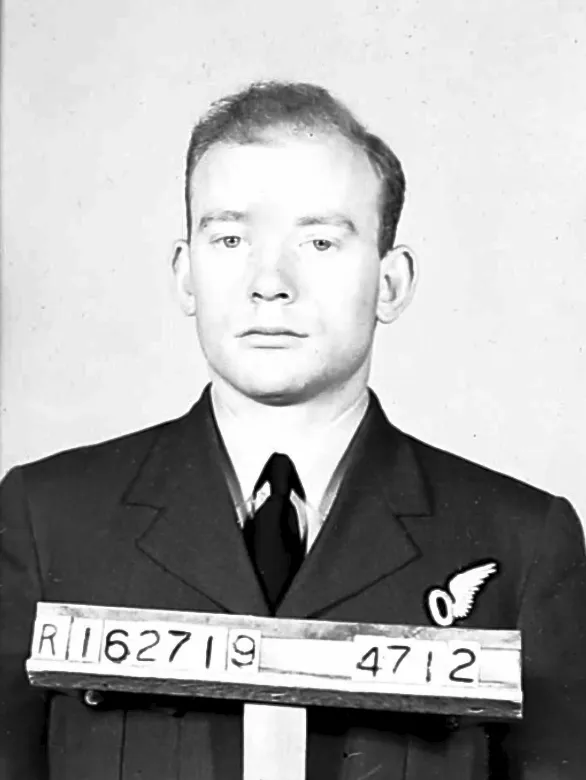

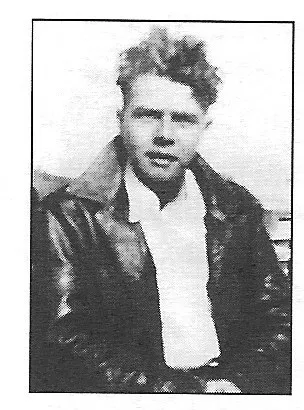

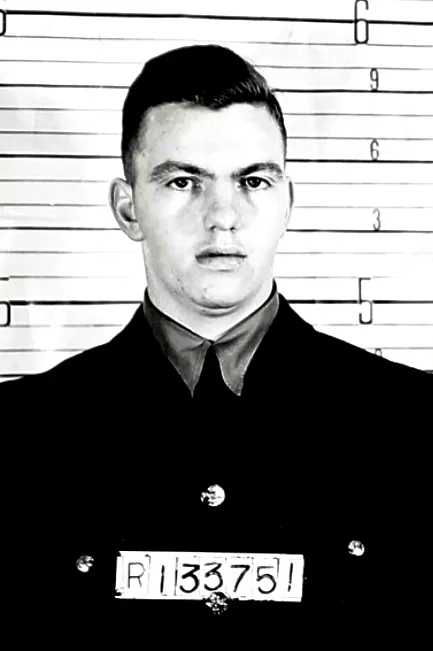

 Lancaster Bomber
Lancaster Bomber Wikipedia
Wikipedia Harold A Skaarup Web Page
Harold A Skaarup Web Page